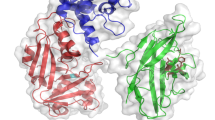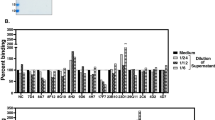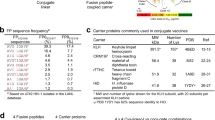Abstract
Diphtheria toxin (DT) is a single polypeptide chain of molecular weight 62,000 with two disulphide bridges1. Immunization against diphtheria rests on the stimulation of antibodies against detoxified toxin which also combine with the native toxin. Because the antibodies differ functionally from each other, however, only some of them are able to neutralize toxicity2–4. We have therefore set out to synthesize part of the amino acid sequence of the toxin whose function as a stimulator of antibodies might be less ambiguous, and have chosen the loop of 14 amino acids subtended by the disulphide bridge nearer the NH2 terminus of the molecule (Fig. 1). There is reason to think that this loop may be involved in the toxicity and immunological specificity of the molecule1,5. We report here our finding that the tetradecapeptide (residues 188–201), when linked covalently with two different carriers, will elicit in guinea pigs antibodies which not only bind specifically with the toxin but neutralize its dermonecrotic and lethal effects. To our knowledge these results constitute the first example of successful active immunization against a lethal bacterial toxin using a synthetic antigen.
This is a preview of subscription content, access via your institution
Access options
Subscribe to this journal
Receive 51 print issues and online access
$199.00 per year
only $3.90 per issue
Buy this article
- Purchase on Springer Link
- Instant access to full article PDF
Prices may be subject to local taxes which are calculated during checkout
Similar content being viewed by others
References
Pappenheimer, A. M. Jr A. Rev. Biochem. 46, 69–94 (1977).
Raynaud, M. in Mechanisms of Hypersensitivity (eds Shaffer, J. H., Lo Grippo, G. A. & Chase, M. W.) 27–46 (Little Brown, Boston, 1959).
Raynaud, M. in Antibodies to Biological Active Molecules Vol. 1 (ed. Cinader, B.) 197–251 (Pergamon, London, 1966).
Pappenheimer, A. M. Jr, Uchida, T. & Harper, A. A. Immunochemistry 9, 891–906 (1972).
Collier, R. J. Bact. Rev. 39, 54–85 (1975).
Drouault, R., Valero, D. & Rivaille, P. Proc. XVth Eur. Peptide Symp. 607–609 (Wroclaw University Press, 1979).
Scotchler, J., Lozier, R. & Robinson, A. B. J. org. Chem. 35, 3151–3152 (1970).
Pietta, P. G., Cavallo, P. F., Marshall, G. & Pace, M. Gaz. chim. Ital. 103, 483–489 (1973).
Chedid, L., Audibert, F. & Johnson, A. G. Prog. Allergy 25, 63–105 (1978).
Parant, M. Springer Semin. Immunopath. 2, 101–118 (1979).
Alouf, J. E. in Immunologie (ed. Bordet, P.) 209–270 (Flammarion Medecine-Sciences, Paris, (1978).
Arnon, R. Colloques INSERM, Paris 72, 11–24 (1977).
Arnon, R., Maron, E., Sela, M. & Anfinsen, C. B. Proc. natn. Acad. Sci. U.S.A. 68, 1450–1455 (1971).
De Lange, R. J., Williams, L. C., Drazin, R. E. & Collier, R. J. J. biol. Chem. 254, 5838–5842 (1979).
Falmagne, P., Lambotte, P., Capiau, C., Ruysschaert, J. M. & Dirkx, J. Toxicon 17, Suppl. 1, 46 (1979).
Author information
Authors and Affiliations
Rights and permissions
About this article
Cite this article
Audibert, F., Jolivet, M., Chedid, L. et al. Active antitoxic immunization by a diphtheria toxin synthetic oligopeptide. Nature 289, 593–594 (1981). https://doi.org/10.1038/289593a0
Received:
Accepted:
Issue Date:
DOI: https://doi.org/10.1038/289593a0
This article is cited by
-
New approaches for control of infections using synthetic or semi-synthetic constructs containing MDP
Springer Seminars in Immunopathology (1985)
-
Genetic engineering and pharmaceuticals
Nature (1984)
Comments
By submitting a comment you agree to abide by our Terms and Community Guidelines. If you find something abusive or that does not comply with our terms or guidelines please flag it as inappropriate.



